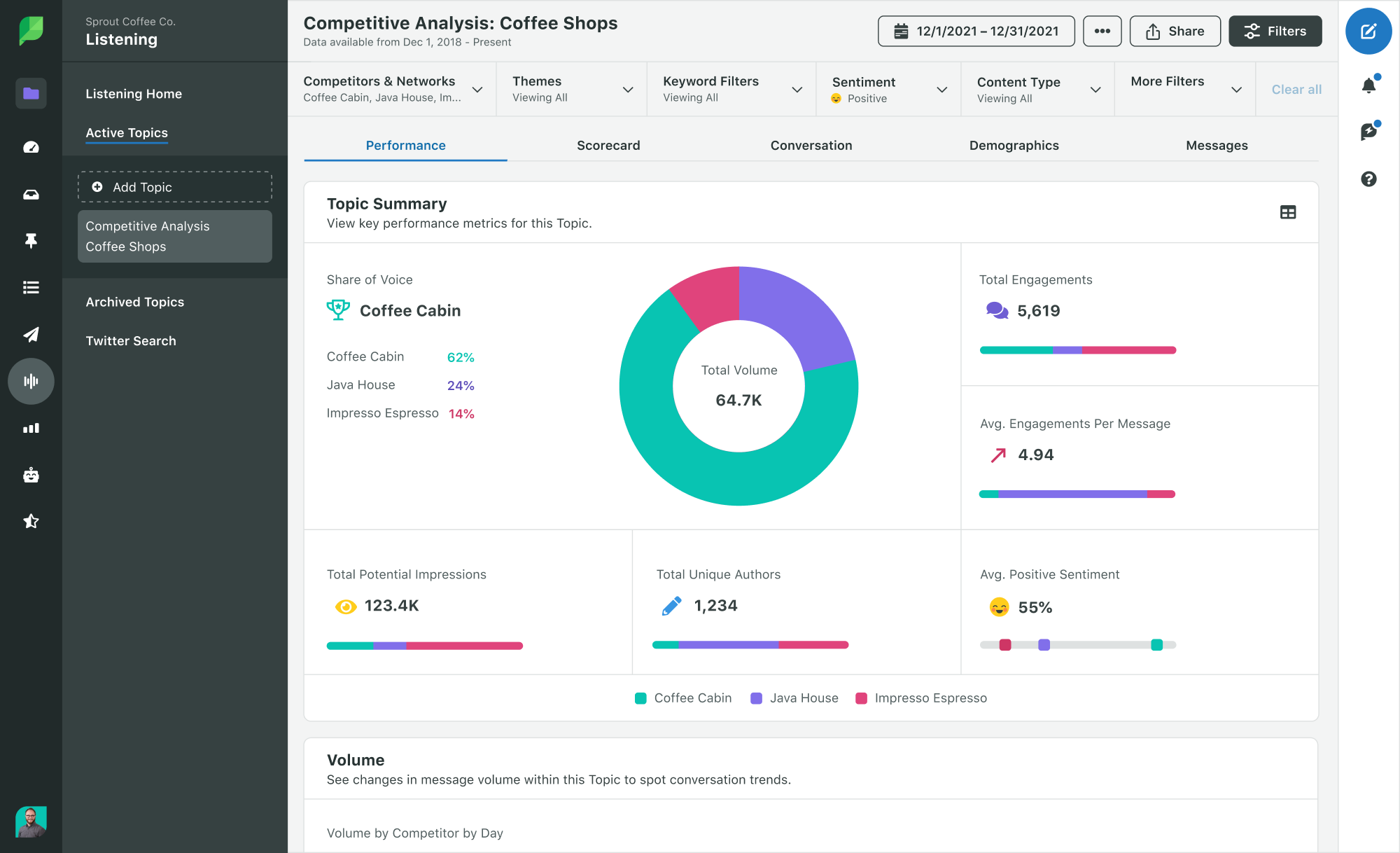How to use sentiment analysis to analyze customer opinion
How to use sentiment analysis to analyze customer opinion
Dive into the world of sentiment analysis to boost your brand strategy. Read about all its intricacies, types, challenges and transformative impact on customer engagement and loyalty.
Reading time 11 minutes
Published on December 17, 2025
Table of Contents
Summary
- Sentiment analysis enables brands to quickly analyze vast amounts of data to understand brand perception, identify emerging trends and make data-driven decisions. This helps brands build a customer-centric business and stay relevant in a fiercely competitive landscape.
- It provides brands with insights into customer opinions and emotions, so they can strategically improve products, tailor marketing strategies and enhance customer experiences.
- Sentiment analysis uses AI techniques such as natural language processing and machine learning to calculate sentiment in customer experience data such as social media comments, reviews and surveys.
A great relationship depends on how sincerely you understand the other person. And this hinges on listening and paying close attention to what they say and how they feel. The same principle applies to brands and consumers.
To stay connected, brands must consistently measure and analyze market sentiment, asking critical questions like “How do customers feel about my brand?”, “Are my customers likely to switch to a competitor?” or “What content resonates most with my audience?”
AI techniques like sentiment analysis automate this process. Sentiment analysis can process large volumes of comments quickly and surface trends faster than manual review. In other words, they take the guesswork out of the equation.
In a world where customer loyalty is fickle and competition gains ground quickly, sentiment analysis provides an efficient way to extract important insights from social listening and online reviews. This valuable information supports you in building meaningful relationships with your audience that drive long-lasting brand loyalty and increase market share.
In this article, we’ll explore what sentiment analysis is, why it’s essential for your business, how it works, and the different types you can leverage to increase your brand strategy’s impact.
What is sentiment analysis?
Sentiment analysis is an AI technique for determining if customer opinions in text are positive, negative or neutral. This technology processes social media comments, reviews and messages to reveal how people feel about your brand, products or services in real-time.
Brands use sentiment analysis tools in AI marketing to surface critical information in voice of the customer (VoC) data from various sources to track brand health, improve products and increase customer engagement and retention. These sources include social listening data, reviews, surveys, customer care interactions and direct messages.
Tools like Sprout Social have sentiment mining as a built-in feature of AI automation so you can proactively harness social insights to monitor brand health, improve efficiency and drive business impact.
Why is sentiment analysis important?
A sentiment analysis tool supports brands to examine conversations and interactions, so they identify customer preferences at each stage of the customer journey.
Sentiment analysis transforms raw customer feedback into strategic advantages:
- Speed and scale: Process millions of comments in seconds
- Accuracy: Reduce human bias in sentiment scoring
- Real-time insights: Spot trends and crises as they happen
- Multilingual support: Understand global audiences
- Campaign optimization: Measure marketing effectiveness in real time
Gain timely insights at speed and scale
Sentiment analysis tools process hundreds of comments in minutes and handle millions of API calls daily. This supports brands in getting timely customer insights to monitor brand performance to grow and engage audiences.

Get more accurate sentiment scores
Machine learning algorithms calculate sentiment from scattered customer feedback data at scale and measure scores with more accuracy than human analysis. This also reduces the scope of biases through human emotion that can creep in. For example, a store manager ignores a negative comment because it’s from a former employee.
Identify sentiment in recurring topics and themes
See sentiment in recurring topics around your business on social media to know if they’re positive or negative. Word clouds also give you a quick view of the important themes and topics in customer discussions.

Pairing these trending topics with sentiment supports a comprehensive understanding of customer opinions about your brand. Plus, it gives you actionable insights to improve your products, offerings and customer care.
Analyze multilingual VoC data
Multilingual data is common in social listening. Sentiment analysis tools enable brands to understand culturally and ethnically diverse customers for a holistic understanding of brand sentiment.
Improve marketing campaigns and brand health
Brands measure key performance indicators (KPIs) with accuracy to identify which parts of their strategy are effective and which need improvement. This is crucial for evaluating the success of marketing campaigns and making real-time adjustments to ensure better results. Also, manage brand perception and draw brand insights by monitoring sentiment in social mentions and customer reviews.
Real-time sentiment analysis for social media
Real-time sentiment analysis moves you from reactive to proactive brand management. Real-time monitoring can help you catch negative spikes earlier, so you can respond faster when an issue starts gaining traction. Plus it helps you discover viral content opportunities before competitors do.
According to the 2025 Sprout Social Index™, 73% of social media users expect brand responses within 24 hours. Real-time sentiment monitoring ensures you’re not just fast; you’re first.
How does sentiment analysis work?
Sentiment analysis is a complex process, so we’ve broken it down into three essential steps.
Step 1: Data collection
It’s important to choose the source of your VoC data as it will affect the accuracy of your sentiment analysis insights. Social media platforms and online platforms your target audience uses most frequently are often the best sources. Ensure the sentiment analysis tool you use integrates with these networks so you get the most accurate insights about customer opinions about your brand and industry.
Steps 2 & 3: Data processing and sentiment mining
Once the tool collects the data, it’s automatically cleaned to make it readable by text analysis algorithms. The tool removes special characters and redundant information, then tokenizes it.
Named entity recognition (NER) then identifies brand mentions, locations, currencies and other information relevant to the insights you want to gather. After this, semantic search algorithms support the tool in understanding comment context and avoiding duplicate entries. This leads to more accurate sentiment scores.
NLP sentiment analysis identifies terms in the data that denote emotions, while part-of-speech (POS) taggers ensure non-English data is natively analyzed for multilingual sentiment analysis. All these steps help with noise filtration so only relevant information is collected based on your goals.
You see this action in Sprout Social’s Query Builder when you select the Exclude Noise option. This capability ensures that all comments with a unique set of keywords are excluded. You can also create rulesets based on themes such as customer service or product reviews.

Then, the tool calculates the sentiment polarity of each clustered topic and aspect to provide the overall sentiment score.
Step 4: Data visualization
The tool visualizes sentiment trends and data patterns into charts and graphs, which you also share with other teams like marketing and customer service. These include metrics like:
- Overall sentiment with classification
- Changes in sentiment over time
- Related keywords and hashtags
- Sentiment overview on specific social media platforms
- Sentiment overview by data source (text, tag, media type, etc)
- Sentiment overview by country, region and other demographics
What are the types of sentiment analysis?
The three most common types of sentiment analysis are Document-based, Topic-based and Aspect-based sentiment analysis (ABSA)—all of which depend on the degree of the algorithm’s ability to detect sentiment polarity expressed in a given text. Brands can choose different types of sentiment analysis based on their specific needs.
| Type | Scope | Best Use Case | Accuracy Level |
|---|---|---|---|
| Document-based | Entire document | Overall sentiment assessment | Basic |
| Topic-based | Specific topics/themes | Multi-topic content analysis | Intermediate |
| Aspect-based (ABSA) | Specific features/attributes | Detailed product feedback | Advanced |
Document-based sentiment analysis
Document-based sentiment analysis evaluates the overall sentiment of an entire document. Brands use this type to understand the general sentiment in individual comments, long-form articles and reports.

Topic-based sentiment analysis
Topic-level sentiment analysis is used to understand complex or scattered data. It breaks down sentences and paragraphs to identify recurring words and phrases and classifies them into topics, which it measures individually for sentiment.
When used to analyze customer comments on social media or review platforms, topic analysis helps you better understand the key points mentioned in the text, which you can then track.

Aspect-based sentiment analysis
Aspect-based sentiment analysis (ABSA) is the most sophisticated of the three. It uses semantic classification to understand comments that don’t contain high-intensity positive words such as “love” or “hate” to calculate sentiment. This also helps it understand the context necessary for accurate sentiment scores.
For example, this X post does not have words that denote high-intensity sentiment. Instead, it has a conversational tone and says that the cute notes and autumn stickers make the customer return to the store. Advanced sentiment mining through ABSA breaks down complex sentences, identifies aspects such as cutesy, cup and notes and understands words such as “return” to identify the general sentiment (positive) and calculate sentiment polarity.

This advanced capability makes ABSA the preferred method to get the most accurate sentiment results, so brands can make informed decisions.
Business applications of sentiment analysis
Here are some important ways sentiment analysis helps brands monitor shifts in market and consumer trends and stay ahead of competitors.
Monitor industry trends
Brands have to constantly keep up with changing industry trends and customer preferences. Sentiment analysis helps you monitor social and online chatter simultaneously from multiple platforms to track emerging trends in consumer feelings across timelines. This enables you to be ahead of the curve and proactively improve your products and services for maximum return on investment (ROI).
Conduct competitive analysis
Sentiment analysis helps you examine conversations about competing brands to track their strengths and weaknesses and inform your business strategy. With Sprout Social, see a side-by-side competitor comparison of key performance metrics across social such as share of voice, engagement, impressions and user sentiment all in one place.
For even more detail, competitive monitoring is an effective way to gather and understand how your competition performs in terms of sentiment and a number of other metrics compared to your brand.

Create engaging content
Create compelling content that resonates with your customers and outperforms your competitors. Analyze sentiment in social listening and review hot topics to build closer relationships with your audience through personalized content based on what they’re talking about.
The NBA team Atlanta Hawks uses sentiment analysis as part of their strategy to grow their brand by creating engaging content that resonates with their fans. By keeping track of audiences’ evolving tastes, sentiment toward the brand and using actionable insights from Sprout Social, the team increased their video views by 127.1% and grew their Facebook audience by 170.1% within three months.
Nurture employee advocacy
Maximize brand amplification and level up employee advocacy by automating the delivery of impactful content to employees, like Medallia did using Sprout. Using sentiment analysis to know what inspires audiences the most helps you build a holistic strategy to reach a bigger audience with automated content distribution.
Improve brand reputation and increase ROI
Positive brand mentions like customer recommendations or praise are important to track so you can reshare positive mentions to amplify your brand and build social proof. Also, alerts based on keywords or for a particular brand campaign support you in measuring market sentiment and taking necessary action based on your insights.
Uncovering these insights also helps brands optimize business operations and improve ROI, as building materials pioneer James Hardie® did using sentiment analysis. The brand uses sentiment insights from social listening to improve brand health and shares insights with its sales and product teams to drive strategic improvements.
Triage inbound messages
Identify incoming messages from frustrated or unhappy audience members so customer care teams prioritize and act with speed. Sprout users on the Advanced Plan can tap into AI-powered sentiment in the Smart Inbox and Reviews Feed.
Posts are assigned a positive, neutral, negative or unclassified value, so it’s easy to isolate messages and assign Automated Rules according to sentiment. Sprout Social’s Smart Inbox automatically assigns messages by sentiment, enabling instant prioritization.
Set up Automated Rules to route negative sentiment messages to senior team members while positive mentions flow to your brand advocacy team. While manual analysis has its place, brands are rapidly moving towards automated solutions powered by AI sentiment analysis.
Challenges in sentiment analysis
Even advanced sentiment analysis faces specific challenges that impact accuracy:
- Sentiment polarity: Sentiment analysis identifies keywords that denote emotions, such as “love”, “hate” or “best” which have high positive (+1) and negative (-1) polarity scores. The challenge arises when the text has phrases such as “not so bad”, which the model doesn’t recognize. This can result in an incorrect sentiment score.
- Sarcasm: People use irony and sarcasm in casual conversations and memes on social media. Machine learning doesn’t recognize backhanded compliments as negative and can misconstrue a sarcastic remark as positive.
- Emojis: Sentiment analysis primarily analyzes text to identify emotions, but comments on social media can be inundated with emojis. To overcome this problem, you need tools such as Sprout that identify emojis in text data and consider them while measuring brand or product sentiment.
- Figures of speech: Machine learning programs don’t understand figures of speech such as idioms and metaphors. For example, an idiom like “under the weather” will make no contextual sense to a sentiment analysis tool. It will disregard the text and this decreases the accuracy of results.
- Negations: A sentiment mining tool doesn’t recognize double negatives in sentences such as, “I can’t not have my Starbucks!”. In such cases, the tool will either disregard the comment or classify it as negative, thus skewing the sentiment score.
- Comparative sentences: Comparative sentences are tricky because they don’t specify whether the customer is happy or unhappy unless specified. For example, a customer’s preference determines if the comment “The Galaxy S20 is larger than the Apple iPhone 12” is positive or negative.
- Multilingual sentiment analysis: When comments are in multiple languages, it compounds the challenges of a sentiment analysis algorithm. Luckily, this problem is solved when the tool has built-in native multilingual sentiment mining, like Sprout Social.
How is sentiment score calculated?
Sentiment scores are measured in polarities, where -1 is negative, 0 is neutral and 1 is positive. There are three ways to calculate these scores:
Word count method
In this method, sentiment scores are calculated by reducing the number of negative occurrences from the positive ones. For example, 1 – 2 = -1. Thus, the sentiment measured is negative. This method is used for simple texts.
Sentence length method
This method calculates the score based on sentence length by subtracting the total number of positive occurrences from the negative ones and then dividing the result by the total number of words.
Word count ratio method
This is the most popular way to calculate sentiment scores. The total number of positive occurrences in the text is divided by the total number of negative ones and increased by one. For example, 1/ 2+1 = 0.33333.
Sentiment scores are calculated in percentiles to give you the overall score of your brand, product or customer experience data.
Learn more about the advancements made in calculating sentiment scores.

What are the sources of sentiment analysis data?
Sources of sentiment analysis data come from various platforms where people express their opinions, like social media, customer reviews and surveys. These data sources provide a wealth of unstructured text to analyze for customer sentiment, brand perception and rising market trends.
Primary data sources include:
- Social media platforms: X (formerly known as Twitter), Facebook, Instagram, TikTok, LinkedIn
- Review platforms: Google My Business, Yelp, Tripadvisor, Glassdoor
- Customer communications: Support tickets, emails, live chat transcripts
- Survey responses: NPS surveys, customer satisfaction forms
- News and media: Articles, press releases, podcast mentions
Social media is a comprehensive bank of unfiltered thoughts and opinions that people express on various topics. It’s one of the best sources to get deeper insights into how your customers feel about your brand, content or customer service. With Sprout Social, measure this sentiment from a range of platforms like X (formerly known as Twitter), Facebook and Instagram—all in one centralized platform.
Business review platforms help you measure brand health. Sprout Social supports your analysis of several review platforms like Google My Business, Yelp, Tripadvisor and Glassdoor to collect actionable data.

Unlock customer sentiments for better brand decisions
It’s important to continuously monitor and measure customer sentiment to enhance your brand perception and deepen customer loyalty. It’s also the most reliable way to ensure long-lasting customer relationships for sustainable revenue generation.
Transform customer conversations into competitive advantages with Sprout Social’s AI-powered sentiment analysis. Monitor brand health across all major social platforms, automate crisis response and turn insights into action.
See sentiment analysis in action. Start your free Sprout Social trial today.
Frequently asked questions about sentiment analysis
Can ChatGPT do sentiment analysis?
Yes, but dedicated social media platforms like Sprout Social integrate sentiment insights directly into your workflows for immediate action.
What are the three types of sentiment analysis?
Document-based (overall sentiment), topic-based (specific subjects) and aspect-based (detailed features).
How accurate is sentiment analysis for social media?
Accuracy depends on AI model quality and social media training. Sprout Social’s AI is specifically tuned for social conversations.
What's the difference between sentiment analysis and social listening?
Social listening monitors conversations; sentiment analysis categorizes them as positive, negative or neutral.
How quickly can sentiment analysis detect brand crises?
Instantly with real-time monitoring and automated alerts for negative sentiment spikes.
Additional resources for How to use sentiment analysis to analyze customer opinion
How to use sentiment analysis to analyze customer opinion
Harnessing X (Twitter) sentiment analysis for strategic business insights
Social media sentiment analysis: Benefits and guide for 2025
Top 16 sentiment analysis tools to consider in 2025
Measure brand health accurately with AI sentiment analysis
How to analyze customer sentiment to improve customer experience
Sentiment analysis examples: How marketers are unlocking consumer insights
How a sentiment score improves your brand strategy
The role of sentiment analysis in marketing








Share